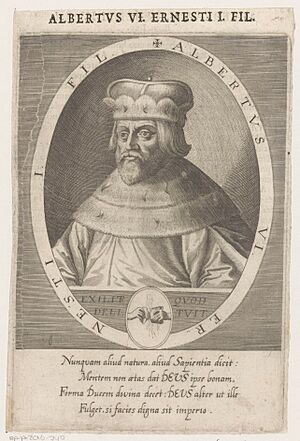Albert III, Duke of Bavaria facts for kids
Quick facts for kids Albert III |
|
|---|---|

Engraving of Albert III, 17th century
|
|
| Duke of Bavaria-Munich | |
| Reign | 2 July 1438 - 29 February 1460 |
| Predecessor | Ernest |
| Successor | John IV |
| Born | 27 March 1401 Wolfratshausen |
| Died | 29 February 1460 (aged 58) Munich |
| Burial | Andechs |
| Spouse | Agnes Bernauer Anna of Brunswick-Grubenhagen-Einbeck
(m. 1437) |
| Issue |
|
| House | House of Wittelsbach |
| Father | Ernest, Duke of Bavaria |
| Mother | Elisabetta Visconti |
Albert III the Pious of Bavaria-Munich (German: Albrecht III. der Fromme, Herzog von Bayern-München; born March 27, 1401 – died February 29, 1460) was a powerful ruler. He became the Duke of Bavaria-Munich in 1438. Albert was the son of Ernest, Duke of Bavaria and Elisabetta Visconti.
Contents
Life as a Duke
Early Life and First Marriage
In 1429, Albert was supposed to marry Elisabeth. However, she ran off and married someone else.
A few years later, in 1432, Albert secretly married Agnes Bernauer. She was a commoner from Augsburg. His father, Duke Ernest, was very much against this marriage. Sadly, in 1435, while Albert was away, his father had Agnes removed from the picture.
Reconciliation and Second Marriage
After this sad event, Albert spent some time with another duke. But by November, he made up with his father.
After making peace, Albert married Princess Anna of Brunswick-Grubenhagen-Einbeck. They had ten children together.
Becoming Duke and His Rule
In 1438, Albert took over from his father as the Duke of Bavaria-Munich. He was a busy ruler.
Around 1438-1439, he built Blutenburg Castle. It was a hunting lodge located near the River Würm. His third son, Sigismund, later made it even bigger.
In 1440, Albert was offered the crown of Bohemia, but he said no.
In 1442, he made a decision to expel Jewish people from all areas of Upper Bavaria. It was not until 250 years later that Jewish families were allowed to live there again.
Albert also led two military campaigns in 1444 and 1445. These were against "Robber barons". These were nobles who used their castles to rob travelers.
In 1447, another duchy, Bavaria-Ingolstadt, no longer had a ruler. Albert gave this land to his father's cousin, Henry XVI of Bavaria-Landshut.
Later Years and Legacy
In 1455, Albert founded a Benedictine monastery. This monastery was located in Andechs.
Albert III died in Munich in 1460. He was buried at the monastery he founded in Andechs.
Family and Children
On January 22, 1437, Albert married Anna of Brunswick-Grubenhagen-Einbeck in Munich. Anna was the daughter of Duke Eric I of Brunswick-Grubenhagen. They had many children:
- John IV, Duke of Bavaria (born October 4, 1437, Munich – died November 18, 1463, Haidhausen).
- Ernest (born August 26, 1438, Munich – died February 29, 1460, Straubing).
- Sigismund of Bavaria (born 1439, Straubing – died February 1, 1501, Blutenburg Castle).
- Albert (born December 24, 1440 – died 1445, Straubing).
- Margaret (born January 1, 1442, Munich – died October 14, 1479, Mantua). She married Federico I Gonzaga in Mantua on May 10, 1463.
- Elisabeth (born February 2, 1443 – died March 5, 1486, Leipzig). She married Elector Ernst of Saxony in Leipzig on November 19, 1460.
- Albert IV, Duke of Bavaria (born December 15, 1447, Munich – died March 10, 1508, Munich).
- Christoph, Duke of Bavaria (born January 6, 1449 – died August 8, 1493, Rhodes).
- Wolfgang (born November 1, 1451 – died May 24, 1514, Landsberg am Lech). He became a church official.
- Barbara (born June 9, 1454, Munich – died June 24, 1472, Munich). She became a nun.
Sources
|
Albert III, Duke of Bavaria
Born: 27 March 1401 Died: 29 February 1460 |
||
| Regnal titles | ||
|---|---|---|
| Preceded by Ernest |
Duke of Bavaria-Munich 1438–1460 |
Succeeded by John IV |

